
Higher and foundation tiers

Rutherford's gold foil experiment or alpha scattering experiment as it is often referred to follows on from J.J. Thomson's discovery of the electron and the plum pudding model of the atom in which he proposed that the atom consisted of a sphere of positive charge in which were embedded the negatively charged electrons. If you are not familiar with this model of the atom then have a quick recap before reading this page.
In 1904 Professor J.J. Thomson suggested a model to describe the internal structure of the atom based on his ideas and experimental work.
Thomson's model of
the atom is often called the plum pudding model. His model described the atom as a sphere of
positive charge in which are embedded the negatively charged electrons; a bit like a plum pudding or chocolate chip
cookie.
 One of Professor Thomson's students at Cambridge University was the brilliant scientist Ernest
Rutherford. In
1911 Rutherford with help from two other research scientists; Hans Geiger and Ernest Marsden conducted
a now very famous experiment which led to the idea that atoms contain a nucleus and his ideas proved that the plum pudding model proposed earlier by J.J. Thomson was in fact wrong. An outline and details of Rutherford's gold foil experiment is described below.
One of Professor Thomson's students at Cambridge University was the brilliant scientist Ernest
Rutherford. In
1911 Rutherford with help from two other research scientists; Hans Geiger and Ernest Marsden conducted
a now very famous experiment which led to the idea that atoms contain a nucleus and his ideas proved that the plum pudding model proposed earlier by J.J. Thomson was in fact wrong. An outline and details of Rutherford's gold foil experiment is described below.
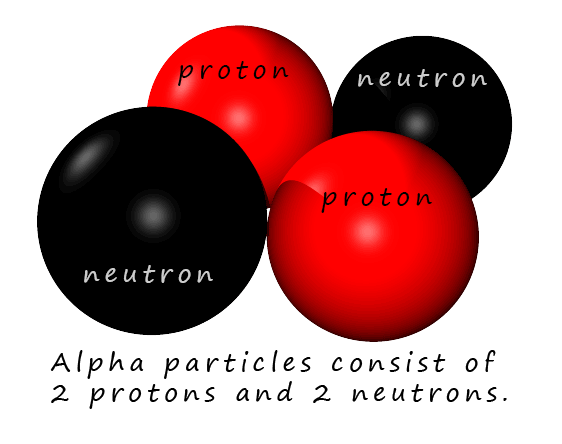
A sample of radioactive radium metal was placed inside a lead block with a hole at one end. Radioactive radium metal has an unstable nucleus and it emits alpha particles. Alpha particles are large heavy fast moving particles and they have lots of kinetic energy, they are like small fast moving "bullets". However they will collide with the gas molecules present in the air and so they can only travel only a few centimetres through the air.
Alpha particles have a charge of 2+, since they consist of 2 protons and 2 neutrons, in fact alpha particles are similar to the nucleus of a helium atom. Since alpha particles are only able to travel a few centimetres in air the whole experiment proposed by Rutherford was carried out in a sealed container in which the most of the air was sucked out by a vacuum pump. Next the alpha particles which were emitted by the radioactive radium atoms travelled towards a very thin sheet of gold foil as outlined in the image below:
Now based on Thomson's plum pudding model of the atom Rutherford knew that the sphere of positive charge proposed by Thomson's model of the atom would not be able to stop the dense fast moving alpha particles so Rutherford expected most of the alpha particles which were fired at the thin sheet of gold foil to simply pass straight through.
The image below outlines the set-up Rutherford used in his experiment. He was able to detect the alpha particles as they
emitted a glow when they struck the fluorescent screen shown in the image below. From the image you can see that most of the
alpha particles travelled straight through the
gold foil but some were deflected through small angles and a few even bounced straight back; as if they had
hit something solid and heavy!
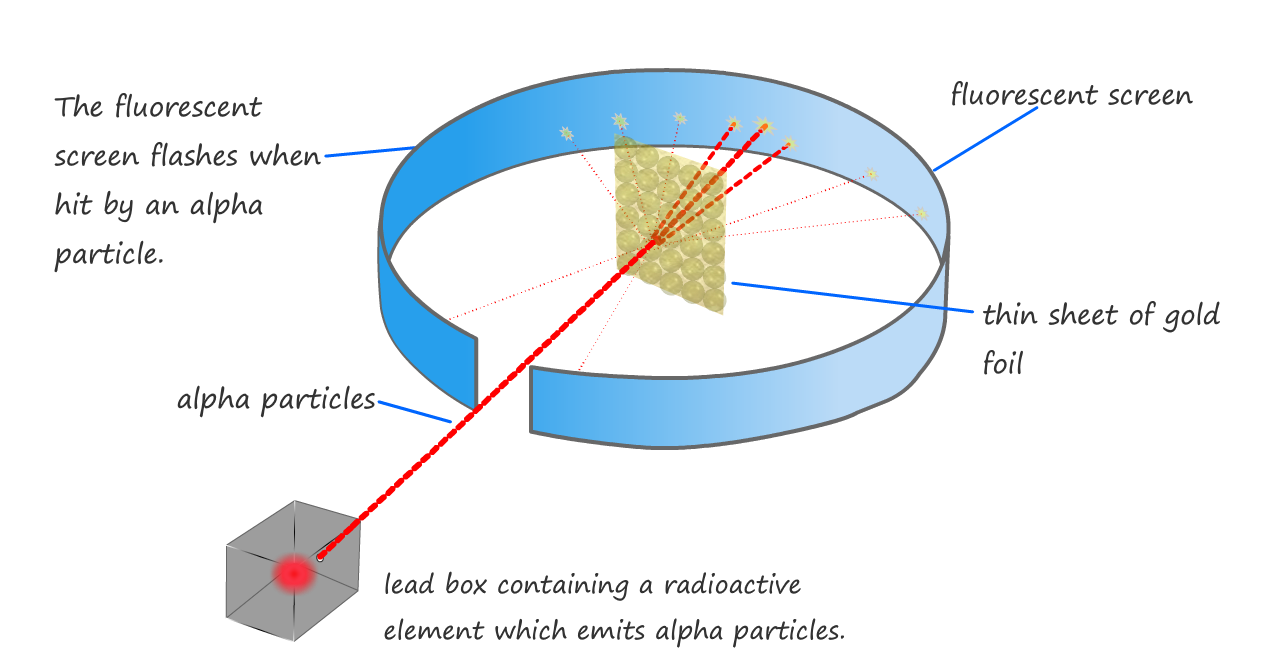
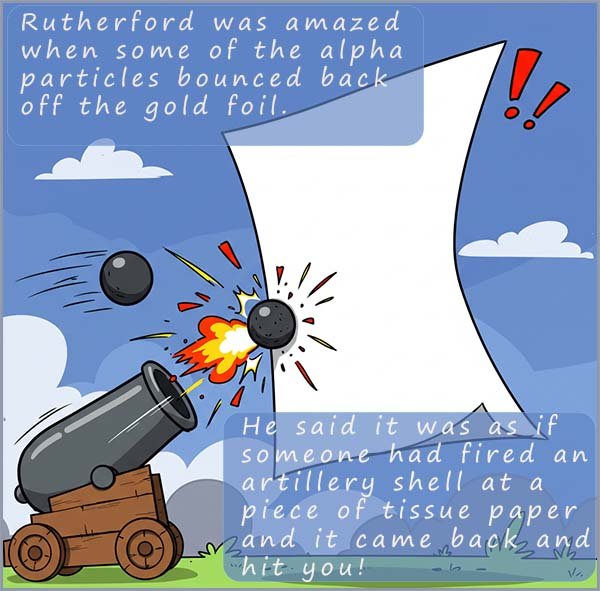
According to Thomson's plum pudding model of the atom the positive charge of the "pudding" was spread out over the whole atom in a cloud of positive charge and it would not have been able to stop a small dense bullet like projectile such as a heavy positively charged alpha particle. So Rutherford would have expected nearly all the alpha particles to pass straight through the gold foil while some may have been deflected through small angles due to the repulsion from the cloud of positive charge.
The results of the experiment did show that most of the alpha particles did indeed pass straight through the gold foil as Rutherford expected but some were deflected through large angles and some even bounced straight back as if they had hit something "solid" inside the gold atoms. This was not what Rutherford was expecting at all. This should have been impossible based on the plum pudding model of the atom. Indeed when Geiger and Marsden presented Rutherford with the results of the scattering experiment Rutherford said:
"Then I remember two or three days later, Geiger coming to me in great excitement and saying we have been able to get some of the alpha particles coming backwards. It was quite the most incredible event that had ever happened to me in my life. It was almost as incredible as if you had fired a 15 inch artillery shell at a piece of tissue paper and it came back and hit you. On consideration I realised that this scattering backwards must be the result of a single collision and when I make my calculations I saw that it was impossible to get anything of the order of magnitude unless you took a system in which the greater mass of the atom was concentrated in a minute nucleus. It was then that I had the idea of an atom with a minute massive centre carrying a positive charge"........
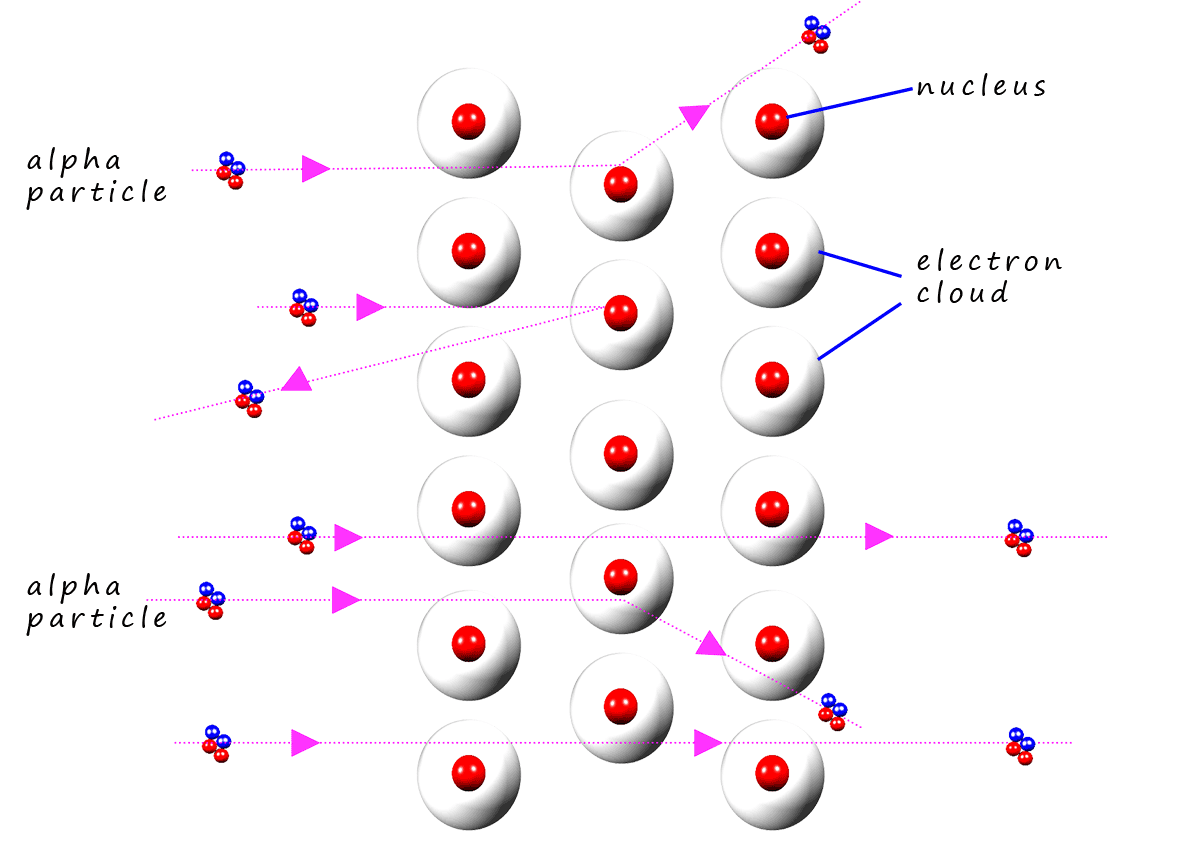
Since most of the alpha particles passed straight through the gold foil (as shown opposite) and only a few were deflected through large angles, Rutherford concluded that the atom consisted of mostly empty space but with a tiny centre of positive charge located at the centre of the atom- the nucleus!
The alpha particles that were deflected were those that had come close to the nucleus; since the alpha particles have a positive charge the closer they got to the positively charged nucleus the greater the repulsion they would feel and the larger the angle through which they would have been deflected through (this is shown in the image opposite).
The fact that very few alpha particles; about 1 in 10 0000 were deflected straight back means that the chance of any of them actually hitting the nucleus must have been small; so the nucleus must be tiny. Rutherford was also able to calculate the size of the nucleus from his experimental work and he calculated that the nucleus was about 1/10 000th the size of the atom.
The results from Rutherford's gold foil experiment proved beyond any doubt that Thomson's Plum Pudding model of the atom was wrong. However it still left some questions unanswered. The main problem with Rutherford's model were the electrons. In Rutherford's model of the atom we have a small dense positively charged nucleus with the electrons simply spinning around it, much like the planets in the solar system as they orbit the Sun. However since the electrons have a negative charge and the nucleus has a positive charge what was there to stop the electrons simply crashing into the nucleus? The answer to this problem was provided by Niels Bohr and led to the idea of electron shells or energy levels in atoms.
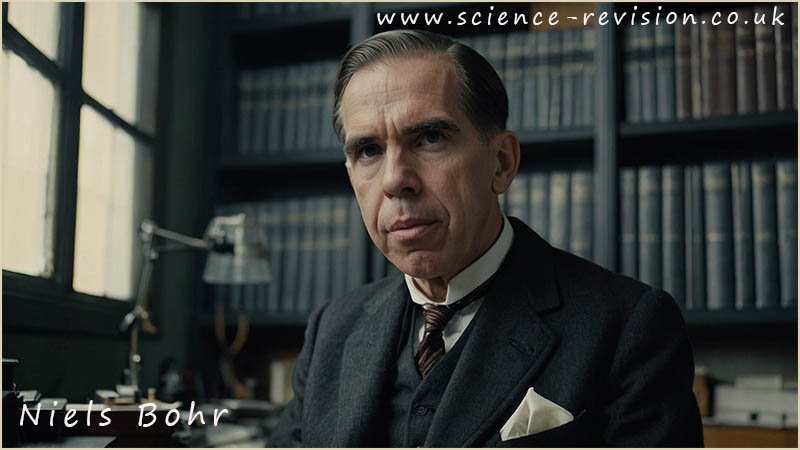
Following Rutherford's work the model to represent the internal structure of the atom that was suggested was one where a small dense nucleus was surrounded by a dense cloud of electrons which orbited around the newly discovered nucleus. Some scientists had the idea that the internal structure of an atom could resemble that of the solar system with the electrons orbiting the small dense central nucleus much like the planets orbiting the Sun. Niels Bohr; a Danish physicist suggested that the electrons orbit the nucleus in discrete well defined orbits at set distances from the nucleus. This is similar to the solar system model but different in one crucial way, the electrons are only allowed to orbit the nucleus in certain shells or energy levels.
What this means in practice is that an electron could be in energy level 1 or electron shell 1 or in electron shell 2 but it CANNOT be an energy level somewhere between energy level 1 and energy level 2. A physicist might say that the energy levels are quantized meaning only certain values are allowed. The first electron shell is lowest in energy and the second electron shell is higher in energy than shell 1 and so on..... electrons occupy the lowest energy level or shell possible at any given time.
Note details of Chadwick's experiments are not required at GCSE. They are
mentioned here purely for your interest.
In 1932 James Chadwick discovered the neutron. His discovery followed work from a number of scientists who had noticed that when alpha particles struck certain materials an unusual type of radiation was emitted.
Polonium is a highly radioactive element which emits alpha particles. It had been noted that if certain elements e.g. beryllium where placed in the path of
alpha particles a strange unknown radiation was produced; see diagram below.
 Chadwick realised that when the alpha particles from the polonium hit the
beryllium the unknown radiation which was produced was uncharged but deeply
penetrating. It was not picked up by the charged particle detector. Paraffin wax when
struck with this unknown new radiation emitted protons. The protons then are recorded by
the detector. Chadwick's measurements and calculations enable him to realise that this
unknown radiation was in fact neutrons.
Chadwick realised that when the alpha particles from the polonium hit the
beryllium the unknown radiation which was produced was uncharged but deeply
penetrating. It was not picked up by the charged particle detector. Paraffin wax when
struck with this unknown new radiation emitted protons. The protons then are recorded by
the detector. Chadwick's measurements and calculations enable him to realise that this
unknown radiation was in fact neutrons.
Summary of Rutherford's gold foil experiment: